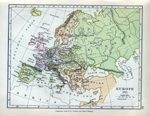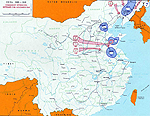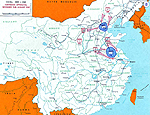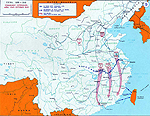|

THE COMMUNIST MANIFESTO - DRAFT
1847
A New World Order
The pros at the
etymology desk
( What is etymology?)
trace the word
communism
back to the French word
communisme, which, in turn,
stems from the French word
commun,
meaning
common.
What is etymology?)
trace the word
communism
back to the French word
communisme, which, in turn,
stems from the French word
commun,
meaning
common.
|
|
Were the French the first ones
in history who came up with the idea
of communism?
Absolutely not.
Ancient Greek
philosopher
 Plato
had already written about it. Plato
had already written about it.
Were
the French the first ones in history
who implemented a system of
communism?
Not at
all. |
So why
do we have the French at the root of
the term communism?
The Origin of the Term Communism
The following is a quote from the 2002 book Communism in
History and Theory - From Utopian Socialism to the Fall of the
Soviet Union by Donald F. Busky.
As for the word
communism, London Owenite*
(John) Goodwyn Barmby (1820-1881) claimed
in 1848 to have first coined the word in 1840.
*=
By the way, what is an Owenite?
An Owenite is a follower of
Robert Owen,
who was from Wales and lived 1771 - 1858. Owen was a social reformer
who for example bought a stretch of land in Indiana, U.S., named it
New Harmony, and had people living and working there together while
sharing their goods. These kind of ideas were called utopian
socialism which was a big hit in the 19th century. Back to quote.
He was on a visit to
Paris at the time. He described how the word came to him. It was
while discussing ideas with some of the disciples of French
revolutionary
Francois Noel "Gracchus" Babeuf that Barmby wrote, "I
also conversed [in 1840] with some of the most advanced minds of the
French metropolis, and there in the company of some of the disciples
of Babeuf, then called Equalitarians, I first pronounced the name Communism, which has since . . . acquired that world-wide
reputation."
Barmby also may have been the first to use
Communist
in 1840. British socialist scholar G.D.H. Cole noted that we find
the words used in his letters from Paris that year published in the
Owenite journal The New Moral World.
However, Barmby, maybe
been mistaken that he was the first to use the words communism
and communist. Cole pointed out that how and when the word communism first came into use cannot be said for certain. In
fact, they were first used in France among the Parisian
revolutionists of the 1830s.
Barmby may have thought that he
invented the words communism and communist, but he was
mistaken. What Cole noted for the words socialism and socialist can also be said for the words
communism and communist: that they were likely used in speech well before
anyone thought to write them down.
Therefore, in all
probability the word socialist was used by the 1820s, socialism by the 1830s, and
communist and communism
by the 1830s or 1840s. Albert S. Lindemann stated that the term communism appeared earlier than
socialism. This may be
so, although it has not been verified. Not until 1842 did
 Karl Marx
use the word communism in print.
Karl Marx
use the word communism in print.
And
 here you can buy Busky's book.
here you can buy Busky's book.
So there we have it. The French are at the root of the term
communism because it was coined in France shortly after the
 French Revolution, which was the ultimate French quest for alternatives to absolute monarchy.
French Revolution, which was the ultimate French quest for alternatives to absolute monarchy.
Now, who was Babeuf?
The French and the Idea of Communism
Mentioned above by author Don Busky was the
French revolutionary
François-Noël Babeuf.
Babeuf disagreed with the Directory,
which was the French Revolutionary government from 1795-1799. How
come?
Because in Babeuf's opinion, the goal of the
 French Revolution
of 1789, i.e. Liberté, Égalité, Fraternité,
which means Liberty, Equality, Brotherhood, stood for
something much more radical.
French Revolution
of 1789, i.e. Liberté, Égalité, Fraternité,
which means Liberty, Equality, Brotherhood, stood for
something much more radical.
In particular, Babeuf argued that true
equality could only be achieved if everybody had the same amount of
money and the same share of property.
Babeuf and others got caught
plotting against the government and people put him on the
 guillotine
in 1797. Babeuf's idea, however, lived on and gained momentum
throughout Europe, regardless of political boundaries.
guillotine
in 1797. Babeuf's idea, however, lived on and gained momentum
throughout Europe, regardless of political boundaries.
And here is a map of Europe from around
that time.

Map of Europe in 1815
Click to enlarge
The Spread of the Communist Thought -
A Timeline of Communism
In France, the communist dream of
Babeuf's friends and followers was rudely interrupted when
 Napoleon declared
himself emperor in 1804.
Napoleon declared
himself emperor in 1804.
In England, and as just read in the
book quote above, Mr Barmby was proud to have been among the
first who used the new terminology in 1840. (See Goodwyn Barmby in
The Apostle No. i. 1848)
In 1842,
 Friedrich Engels
became a communist.
Friedrich Engels
became a communist.
Then
 Karl Marx blew everyone out of the
water with his Communist Manifesto. The year? 1848.
Karl Marx blew everyone out of the
water with his Communist Manifesto. The year? 1848.

KARL HEINRICH MARX
1818 - 1883
Click picture to enlarge
In 1889,
 Lenin
became a Marxist. Lenin
became a Marxist.
In 1892,
 Lunacharsky joined the Bolshevik party.
Lunacharsky joined the Bolshevik party.
The
 Russian Revolution of 1917 made
everyone look. Communism was made official national policy in the
USSR.
Russian Revolution of 1917 made
everyone look. Communism was made official national policy in the
USSR.
In 1921, the Chinese Communist Party
was founded.
After
 World War II followed the
World War II followed the
 Cold War
in which the
Cold War
in which the
 Iron Curtain divided the two camps
on a world map — pro and anti communism.
Iron Curtain divided the two camps
on a world map — pro and anti communism.
In 1948 and 1949, the Communists in China
were on the roll. Here are the maps.

1948 Sept-Nov - China:
Communist Offensives
Click to enlarge

1948 November-January
1949 - China: Communist Offensives
Click to enlarge

1949 April-October -
China: Communist Offensives
Click to enlarge
Outstanding communist stamina can be
studied in the case of
 Fidel Castro.
Fidel Castro.
Remarkable skill in dissolving communism
can be studied in the case of
 Mikhail Gorbachev.
Mikhail Gorbachev.
What Is Communism? The Definition
In a nutshell,
communism is a social system in which the community controls the
economy and in which property is commonly owned.
 Plato
went a step further and also
advocated the sharing of spouses and children. Now I got your
attention. Plato
went a step further and also
advocated the sharing of spouses and children. Now I got your
attention.
Communism is the opposite of capitalism.
What Is the Difference Between Communism and Socialism?
Communism is Socialism
with extra zing.
Here is the more detailed answer phrased
by Paul Sweezy and Leo Huberman in their 1968 Introduction to
Socialism.
What is the difference between Socialism and Communism?
Socialism and communism are alike in that both are systems of
production for use based on public ownership of the means of
production and centralized planning. Socialism grows directly
out of capitalism; it is the first form of the new society.
Communism is a further development or higher stage of socialism.
[...]
The Communists believe that as soon as the working class and its
allies are in a position to do so they must make a basic change
in the character of the state; they must replace capitalist
dictatorship over the working class with workers dictatorship
over the capitalist class as the first step in the process by
which the existence of capitalists as a class (but not as
individuals) is ended and a classless society is eventually
ushered in. Socialism cannot be built merely by taking over and
using the old capitalist machinery of government; the workers
must destroy the old and set up their own new state apparatus.
The workers state must give the old ruling class no opportunity
to organize a counter-revolution; it must use its armed strength
to crush capitalist resistance when it arises.
The Socialists, on the other hand, believe that it is possible
to make the transition from capitalism to socialism without a
basic change in the character of the state. They hold this view
because they do not think of the capitalist state as essentially
an institution for the dictatorship of the capitalist class, but
rather as a perfectly good piece of machinery which can be used
in the interest of whichever class gets command of it. No need,
then, for the working class in power to smash the old capitalist
state apparatus and set up its own. The march to socialism can
be made step by step within the framework of the democratic
forms of the capitalist state.
Why Are There Different Types of Communism?
Marx and Engels were the first who had given a full treatment of the
subject in their Communist Manifesto. People took it from
there and henceforth, the terms Communism and Marxism
were used interchangeably.
Marxism was an idea, meaning Marx never tested his theory in the
lab. Each time somebody tried to implement Marx' idea, the idea had
to be adapted or enhanced according to the individual situation of
that country, their citizens, and so on.
And of course, each interpreter of
Marxism added their own two cents.
What Are the Different Versions and Variants of Communism?
The main categories are...
Marxism
Developed and phrased by
 Karl Marx
and
Karl Marx
and
 Friedrich
Engels.
Friedrich
Engels.
Leninism
Marxism as interpreted by
 Vladimir I.
Lenin. Also called Marxism-Leninism.
Vladimir I.
Lenin. Also called Marxism-Leninism.
Stalinism
Marxism as interpreted by
 Joseph Stalin.
Joseph Stalin.
Trotskyism
Marxism as interpreted by
 Leon Trotsky.
Leon Trotsky.
Emphasis on the importance of revolutions all around the world.
Very much opposed to Stalin's interpretation of Marxism, which
prompted Stalin to send an assassin after Trotsky.
Luxemburgism
Marxism as interpreted by
 Rosa
Luxemburg.
Rosa
Luxemburg.
Luxemburg was against nationalism and for united international
communism.
Maoism
Marxism-Leninism as interpreted by
 Mao Tse-Tung.
Emphasis on agrarian revolution.
Mao Tse-Tung.
Emphasis on agrarian revolution.
Fidelism / Castroism
Marxism as interpreted by
 Fidel Castro.
Fidel Castro.
Anarchism
The term anarchism stems from the Greek
word anarchos, which means without
authority. Property is commonly owned and
equally distributed but no state or government
should exist, because these institutions are by
definition above the community and hence
anti-communist.
Emma Goldman,
also called Red Emma, was an anarchist.
Anarchism is
Communism without Marxism. More
 here.
here.
See also
 Forms of Governments.
Forms of Governments.
What Is the Difference Between Marxism and Leninism?
View of Marxism:
1) The proletariat, which is the working class, should start a
revolution that will ultimately lead to a communist state.
2) Most likely, this revolution will start in advanced capitalist
countries, because they will have the highest amount of exploited,
and thus dissatisfied, workers.
View of Leninism:
To 1) The workers can't get themselves organized for a successful
revolution, the proletariat needs proper leadership. This leadership
will be provided by the communist party, which will run a very tight
ship. (see also
 politburo)
politburo)
To 2) No way the proletariat of the rich countries will start the
communist revolution, their lives are still too painless. It will be
the proletariat of a poorer country, let's say... Russia.
What Is the Difference Between Marxism, Leninism, and Stalinism?
View of Marxism:
1) Everybody is equal.
2) The communist revolution must take place all over the world.
Communists worldwide will support each other.
View of Leninism:
To 1) Everybody is equal but they need a group of leaders to guide
them.
To 2) The communist revolution must take place all over the world
and it starts in Russia.
View of Stalinism:
To 1) Everybody is equal but Stalin is God.
To 2) The communist revolution was successful in Russia, so screw
the rest of the world. Except if the rest of the world could be
used to protect Stalin's empire.
What Is Bolshevism?
Russia under the communist rule of the
Bolsheviks, which started
with the
 Bolshevik Revolution of October (November) 1917. Bolshevik Revolution of October (November) 1917.
What Is the Principal Literature of Communism?
A list of the main books, communist classics, recommended reading to
understand the basics of Marxism.
What Is War
Communism?
War Communism is the
name of the Bolsheviks' financial strategy from
June 1918 until March 1921, essentially the time
during which the
 Russian Civil War
was fought.
Russian Civil War
was fought.
The goal of this strategy was to switch the
Russian economic system from imperialism to
socialism. In practice, this transition
exhausted the citizens.
The Bolsheviks had to pause the radical pursuit
of their goals when
people stopped cooperating in 1921. The strain
was too much, the nation was starving and the inflation had gone through
the roof.
A major indicator
that people weren't able to take it anymore was
the
Kronstadt Rebellion
in March 1921. The event was noted, although
brutally crushed, by
the Bolsheviks and it became clear to them that
it was time to yield if they wanted to keep the
upper hand.
Later in March of
1921, the Bolsheviks switched their economic
policy from War Communism to the
New Economic Policy
(NEP). The NEP was in use until 1928 when
 Stalin
became sick and tired of pussy-footing around.
Stalin
became sick and tired of pussy-footing around.
See also
 American Timeline
American Timeline
More History
|